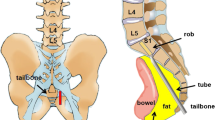Abstract
Study Design
A retrospective study.
Object
To investigate the rate of lumbosacral junction complication after long corrective spinal fusion for degenerative kyphoscoliosis cases with different lower instrumented vertebra (LIV) of L5, S1 (non-iliac group), and ilium (iliac group).
Summary of Background Data
In long spinal fusion, high mechanical stress is concentrated at the fusion ends, especially at the lumbosacral junction. There are conflicting views regarding the selection of lower instrumented vertebra in long spinal fusion for adult spinal deformity.
Methods
This study included 53 adult patients who underwent posterior long corrective fusion (more than five levels) for their spinal kyphoscoliosis with a minimum 2 years’ follow-up. The patients were divided into two groups: distal fusion level was L5, S1 (non-iliac group), or ilium (iliac group). We investigated the complication status (L5/S1 instability, pseudoarthrosis, screw loosening, sacral fracture, and rod fracture) in the lumbosacral junction.
Results
There were 25 patients (L5:6 cases, S1:19 cases) in the non-iliac group and 28 in the iliac group. There was no significant deference in age and preoperative radiographic parameters between the 2 groups. In the non-iliac group, revision surgery was performed in 6 of the 25 cases (24%, LIV L5: 1 case, S: 5 cases). Lumbosacral failure was observed in 3 of 6 cases with LIV at L5 and a radiolucent sign around S1 pedicle screws were observed in 15 of 19 cases in LIV at S. In the iliac group, revision surgery was required because of rod fractures in 2 of 28 cases (7.1%). There was no other major complication in iliac group.
Conclusion
This study showed that a high complication rate at the lumbosacral junction was observed when the L5 or S1 was selected as the distal fusion end in long corrective fusion. On the other hand, the lumbosacral complication rate was low when using iliac screw as the lower fusion end. Thus, we recommend spinopelvic fixation using iliac screw as the lower fusion end of long corrective fusion for the adult spinal deformity surgery, with the high rate of failure in our patients with long fusions stopped at L5 and S1.
Similar content being viewed by others
References
Cho KJ, Suk SI, Park SR, et al. Arthrodesis to L5 versus S1 in long instrumentation and fusion for degenerative lumbar scoliosis. Eur Spine J 2009;18:531–7.
Horton WC, Brown CW, Bridwell KH, et al. Is there an optimal patient stance for obtaining a lateral 36″ radiograph? A critical comparison of three techniques. Spine (Phila Pa 1976) 2005;30:427–33.
Siambanes D, Mather S. Comparison of plain radiographs and CT scans in instrumented posterior lumbar interbody fusion. Orthopedics 1998;21:165–7.
Lee JH, Park JW, Lee HS. Fusion rates of a morselized local bone graft in polyetheretherketone cages in posterior lumbar interbody fusion by quantitative analysis using consecutive three-dimensional computed tomography scans. Spine J 2011;11:647–53.
Aebi M. The adult scoliosis. Eur Spine J 2005;14:925–48.
Edwards 2nd CC, Bridwell KH, Patel A, et al. Thoracolumbar deformity arthrodesis to L5 in adults: the fate of the L5-S1 disc. Spine 2003;28:2122–31.
Horton WC, Holt RT, Muldowny DS. Controversy. Fusion of L5-S1 in adult scoliosis. Spine 1996;21:2520–2.
Pateder DB, Park YS, Kebaish KM, et al. Spinal fusion after revision surgery for pseudarthrosis in adult scoliosis. Spine 2006;31:E314–9.
Tsuchiya K, Bridwell KH, Kuklo TR, et al. Minimum 5-year analysis of L5-S1 fusion using sacropelvic fixation (bilateral S1 and iliac screws) for spinal deformity. Spine (Phila Pa 1976) 2006;31:303–8.
Cunningham BW, Lewis SJ, Long J, et al. Biomechanical evaluation of lumbosacral reconstruction techniques for spondylolisthesis: an in vitro porcine model. Spine 2002;27:2321–7.
Lebwohl NH, Cunningham BW, Dmitriev A, et al. Biomechanical comparison of lumbosacral fixation techniques in a calf spine model. Spine 2002;27:2312–20.
McCord DH, Cunningham BW, Shono Y, et al. Biomechanical analysis of lumbosacral fixation. Spine 1992;17(8 suppl):S235–43.
Fleischer GD, Kim YJ, Ferrara LA, et al. Biomechanical analysis of sacral screw strain and range of motion in long posterior spinal fixation constructs: effects of lumbosacral fixation strategies in reducing sacral screw strains. Spine 2012;37:E163–9.
O’Neill KR, Bridwell KH, Lenke LG, et al. Extension of spine fusion to the sacrum following long fusions for deformity correction. Spine 2014;39:953–62.
Hyun SJ, Rhim SC, Kim YJ, Kim YB. A mid-term follow-up result of spinopelvic fixation using iliac screws for lumbosacral fusion. J Korean Neurosurg Soc 2010;48:347–53.
Smith JS, Shaffrey CI, Ames CP, et al. Assessment of symptomatic rod fracture after posterior instrumented fusion for adult spinal deformity. Neurosurgery 2012;71:862–7.
Harimaya K, Mishiro T, Lenke LG, et al. Etiology and revision surgical strategies in failed lumbosacral fixation of adult spinal deformity constructs. Spine (Phila Pa 1976) 2011;36:1701–10.
Dickson DD, Lenke LG, Bridwell KH, Koester LA. Risk factors for and assessment of symptomatic pseudarthrosis after lumbar pedicle subtraction osteotomy in adult spinal deformity. Spine (Phila Pa 1976) 2014;39:1190–5.
Mattei TA, Fassett DR. Combined S-1 and S-2 sacral alar-iliac screws as a salvage technique for pelvic fixation after pseudarthrosis and lumbosacropelvic instability: combined S-1 and S-2 sacral alar-iliac screws as a salvage technique for pelvic fixation after pseudarthrosis and lumbosacropelvic instability: technical note. J Neurosurg Spine 2013;19:321–30.
Author information
Authors and Affiliations
Corresponding author
Additional information
Author disclosures
TY (none), TH (none), YY (none), SK (none), DT (none), TB (none), HA (none), SO (none), YM (none).
Rights and permissions
About this article
Cite this article
Yasuda, T., Hasegawa, T., Yamato, Y. et al. Lumbosacral Junctional Failures After Long Spinal Fusion for Adult Spinal Deformity—Which Vertebra Is the Preferred Distal Instrumented Vertebra?. Spine Deform 4, 378–384 (2016). https://doi.org/10.1016/j.jspd.2016.03.001
Received:
Revised:
Accepted:
Published:
Issue Date:
DOI: https://doi.org/10.1016/j.jspd.2016.03.001




